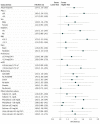Association of Urinary Oxalate Excretion With the Risk of Chronic Kidney Disease Progression
- PMID: 30830167
- PMCID: PMC6450310
- DOI: 10.1001/jamainternmed.2018.7980
Association of Urinary Oxalate Excretion With the Risk of Chronic Kidney Disease Progression
Abstract
Importance: Oxalate is a potentially toxic terminal metabolite that is eliminated primarily by the kidneys. Oxalate nephropathy is a well-known complication of rare genetic disorders and enteric hyperoxaluria, but oxalate has not been investigated as a potential contributor to more common forms of chronic kidney disease (CKD).
Objective: To assess whether urinary oxalate excretion is a risk factor for more rapid progression of CKD toward kidney failure.
Design, setting, and participants: This prospective cohort study assessed 3123 participants with stages 2 to 4 CKD who enrolled in the Chronic Renal Insufficiency Cohort study from June 1, 2003, to September 30, 2008. Data analysis was performed from October 24, 2017, to June 17, 2018.
Exposures: Twenty-four-hour urinary oxalate excretion.
Main outcomes and measures: A 50% decline in estimated glomerular filtration rate (eGFR) and end-stage renal disease (ESRD).
Results: This study included 3123 participants (mean [SD] age, 59.1 [10.6] years; 1414 [45.3%] female; 1423 [45.6%] white). Mean (SD) eGFR at the time of 24-hour urine collection was 42.9 (16.8) mL/min/1.73 m2. Median urinary excretion of oxalate was 18.6 mg/24 hours (interquartile range [IQR], 12.9-25.7 mg/24 hours) and was correlated inversely with eGFR (r = -0.13, P < .001) and positively with 24-hour proteinuria (r = 0.22, P < .001). During 22 318 person-years of follow-up, 752 individuals reached ESRD, and 940 individuals reached the composite end point of ESRD or 50% decline in eGFR (CKD progression). Higher oxalate excretion was independently associated with greater risks of both CKD progression and ESRD: compared with quintile 1 (oxalate excretion, <11.5 mg/24 hours) those in quintile 5 (oxalate excretion, ≥27.8 mg/24 hours) had a 33% higher risk of CKD progression (hazard ratio [HR], 1.33; 95% CI, 1.04-1.70) and a 45% higher risk of ESRD (HR, 1.45; 95% CI, 1.09-1.93). The association between oxalate excretion and CKD progression and ESRD was nonlinear and exhibited a threshold effect at quintiles 3 to 5 vs quintiles 1 and 2. Higher vs lower oxalate excretion (at the 40th percentile) was associated with a 32% higher risk of CKD progression (HR, 1.32; 95% CI, 1.13-1.53) and 37% higher risk of ESRD (HR, 1.37; 95% CI, 1.15-1.63). Results were similar when treating death as a competing event.
Conclusions and relevance: Higher 24-hour urinary oxalate excretion may be a risk factor for CKD progression and ESRD in individuals with CKD stages 2 to 4.
Conflict of interest statement
Figures


Comment in
-
Implications of Oxalate as a Novel Risk Factor for Chronic Kidney Disease.JAMA Intern Med. 2019 Apr 1;179(4):551-552. doi: 10.1001/jamainternmed.2018.7987. JAMA Intern Med. 2019. PMID: 30830214 No abstract available.
-
Re: Association of Urinary Oxalate Excretion with the Risk of Chronic Kidney Disease Progression.J Urol. 2019 Oct;202(4):654-655. doi: 10.1097/JU.0000000000000441. Epub 2019 Sep 6. J Urol. 2019. PMID: 31294659 No abstract available.
-
Re: Association of Urinary Oxalate Excretion with the Risk of Chronic Kidney Disease Progression.J Urol. 2019 Oct;202(4):655. doi: 10.1097/01.JU.0000577624.54891.6c. Epub 2019 Sep 6. J Urol. 2019. PMID: 31294662 No abstract available.
References
-
- Wharton R, D’Agati V, Magun AM, Whitlock R, Kunis CL, Appel GB. Acute deterioration of renal function associated with enteric hyperoxaluria. Clin Nephrol. 1990;34(3):116-121. - PubMed
Publication types
MeSH terms
Substances
Grants and funding
LinkOut - more resources
Full Text Sources
Other Literature Sources
Medical
Research Materials
Miscellaneous

